Telecommunications History Group Resources
Heroes in Telecom History
Robert K. Timothy - Heroes in Telecom History
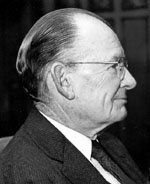 It was 1946 and World War II had just ended. Things were hectic at the phone company. Returning service men and women were returning to the company for their old jobs and new veterans were just looking for their first job at the phone company.
It was 1946 and World War II had just ended. Things were hectic at the phone company. Returning service men and women were returning to the company for their old jobs and new veterans were just looking for their first job at the phone company.
One of the new veterans, a former lieutenant, joined the mix of employees looking for a job. He was hired as a “nickel-snatcher” in his “hometown” of Greeley, Colorado. This means he collected coins from the pay phones in the area and collected overdue bills from customers.
The young lieutenant’s name was Robert K. Timothy, and he began his new job working the only way he knew how. Hard. He’d been born on a dry-land farm near Gilcrest about 14 miles from Greeley where hard work is the only way to survive.
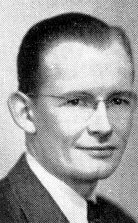 His hard work paid off and in 1949 Timothy was promoted to Manager of the Miscellaneous Unit in the Colorado Springs Mountain Bell Commercial Department. The new job was to test Timothy’s mettle as no other job in his 37- year telephone career.
His hard work paid off and in 1949 Timothy was promoted to Manager of the Miscellaneous Unit in the Colorado Springs Mountain Bell Commercial Department. The new job was to test Timothy’s mettle as no other job in his 37- year telephone career.
In those days the training for a new first-level manager consisted of reading a booklet, asking your second line questions if he was around and doing the job you were assigned. Timothy had been learning the job for less than a year when his boss told him that he was to drive to the airport and pick up his newest customers.
“I wasn’t at a high enough level to get a company car, so I drove to the airport in my ’37 Chevy that I’d bought used from the CCC. It had more than 100,000 miles on it and was rusted through the floor in spots.”
At the airport he met his new customers – Colonel Haskill E. Neil and Major Duffy of the United States Air Force.
On the drive back to the telephone office Timothy found out what his new customers wanted. It wasn’t much really … just that the Air Force was moving its North American Defense Command from Mitchell AFB in New York to Ent AFB in Colorado Springs. NORAD needed an entire telecommunications system designed, installed and working in a matter of weeks.
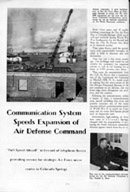 The Cold War was heating up. Atomic bombs, long-range bombers and intercontinental missiles were in the news headlines nearly every day.
The Cold War was heating up. Atomic bombs, long-range bombers and intercontinental missiles were in the news headlines nearly every day.
A year later Mountain Bell would have an entire department dedicated to supplying the Federal Government’s telecommunications needs. In 1950, however, Robert K. Timothy was it.
“I was on the phone with Col. Neil every day, seven days a week. I’d have never made it without his help,” Timothy said. Working more than 100 hours a week, reading BSPs (Bell System Practices), manuals, product descriptions, learning to draw schematics, talking to Western Electric product managers, Timothy came up with a plan, which Col. Neil approved with minor changes.
Timothy ordered the equipment–switches, cable, telephones, TWX machines (teletype), switchboards, emergency power generators, ringing machines, wiring, batteries and thousands of other items. The order went directly to the main Western Electric (the Bell System’s manufacturing arm) order center.
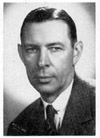 Because of the importance of the job, Walter Koch, Mountain Bell’s president, interceded for Timothy and arranged for him to have absolute top priority at Western Electric, so the company began to build the special items on the day it was received.
Because of the importance of the job, Walter Koch, Mountain Bell’s president, interceded for Timothy and arranged for him to have absolute top priority at Western Electric, so the company began to build the special items on the day it was received.
“I went down to the our loading dock in the Springs and watched the trucks being unloaded. I said to myself, ‘Tim, what have you done?’”
Right after recovering from the shock of the initial order, Timothy remembered a small picture he’d seen in the Monitor, Mountain Bell’s employee magazine. It was a picture of a new type of phone called a key-system phone.
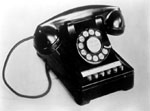 “I remembered that phone and I read some of the Western Electric material about it. It was new and hadn’t really been used in the field, but I knew Western Electric didn’t make junk. It looked like it would do exactly what the Air Force needed and it could be installed while the buildings were under construction, so I ordered it.”
“I remembered that phone and I read some of the Western Electric material about it. It was new and hadn’t really been used in the field, but I knew Western Electric didn’t make junk. It looked like it would do exactly what the Air Force needed and it could be installed while the buildings were under construction, so I ordered it.”
Mountain Bell and Western Electric installers worked around the clock installing the key system, TWX machines, switches, wiring and switchboards for the bigger permanent system to be cut into service later, and on trunk lines and thousands of miscellaneous items. Timothy was at the work site most of the time offering advice, making field changes, running errands and doing whatever else had to be done.
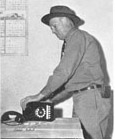 The end result–the entire job from equipment delivery to installation and full operation–was accomplished in 11 days!
The end result–the entire job from equipment delivery to installation and full operation–was accomplished in 11 days!
Col. Neil and Robert K. Timothy became lifelong friends. Col. Neil retired as a four-star Air Force general; Timothy retired as the president of Mountain Bell. Russia retired from the Cold War; perhaps the key-system helped.
Additional Resources:
See more facts about Robert K. Timothy and the events surrounding this story at the following links:
- For more on NORAD, see their website.
- For more on Cheyenne Mountain, visit http://www.norad.mil/About-NORAD/Cheyenne-Mountain-Air-Force-Station/.
- For a history of Greeley, Colorado, see the Greeley website.
